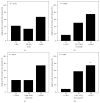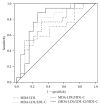Circulating malondialdehyde-modified LDL-related variables and coronary artery stenosis in asymptomatic patients with type 2 diabetes
- PMID: 25883985
- PMCID: PMC4391491
- DOI: 10.1155/2015/507245
Circulating malondialdehyde-modified LDL-related variables and coronary artery stenosis in asymptomatic patients with type 2 diabetes
Abstract
Aims: To elucidate the levels of malondialdehyde-modified LDL (MDA-LDL)-related variables for predicting coronary artery stenosis (CAS) by coronary CT angiography (CCTA) in asymptomatic patients with type 2 diabetes (T2DM).
Methods: Enrolled were 36 Japanese patients with T2DM who underwent CCTA and in whom MDA-LDL levels were measured. Definition of CAS was luminal narrowing of ≥50%. Trends through tertiles of each MDA-LDL-related variable were analyzed with a general linear model. The ability of each MDA-LDL-related variable to predict CAS was compared to areas under the curve (AUCs) in receiver operating characteristic curve (ROC) analysis.
Results: Seventeen patients had CAS. Each MDA-LDL-related variable was an independent predictor of CAS (P = 0.039 for MDALDL, P = 0.013 for MDA-LDL/LDL-C, P = 0.047 for MDA-LDL/HDL-C, and P = 0.013 for (MDA-LDL/LDL-C)/HDL-C). AUCs of MDA-LDL, MDA-LDL/LDL-C, MDA-LDL/HDL-C, and (MDA-LDL/LDL-C)/HDL-C were 0.675 (95% CI 0.496-0.854), 0.765 (0.602-0.927), 0.752 (0.592-0.913), and 0.799 (0.643-0.955), respectively, for predicting CAS. Trends throughout the tertiles showed significant associations between MDA-LDL/LDL-C, MDA-LDL/HDL-C, or (MDALDL/LDL-C)/HDL-C and CAS (P = 0.003 for MDA-LDL/LDL-C, P = 0.042 for MDA-LDL/HDL-C, and P = 0.001 for (MDA-LDL/LDL-C)/HDL-C).
Conclusions: Data suggest that measurements of MDA-LDL/LDL-C, MDA-LDL/HDLC, and (MDA-LDL/LDL-C)/HDL-C are useful for predicting CAS.
Figures


Similar articles
-
Carotid artery plaque and LDL-to-HDL cholesterol ratio predict atherosclerotic status in coronary arteries in asymptomatic patients with type 2 diabetes mellitus.J Atheroscler Thromb. 2013;20(5):452-64. doi: 10.5551/jat.14977. Epub 2013 Jan 30. J Atheroscler Thromb. 2013. PMID: 23363982
-
Antibody titer against malondialdehyde-modified LDL compares with HDL cholesterol concentration in identifying angiographically verified coronary artery disease. Comparison of tests by ROC analysis.Clin Chem Lab Med. 2005;43(4):357-60. doi: 10.1515/CCLM.2005.065. Clin Chem Lab Med. 2005. PMID: 15899649
-
Increased circulating malondialdehyde-modified LDL levels in patients with coronary artery diseases and their association with peak sizes of LDL particles.Arterioscler Thromb Vasc Biol. 2002 Apr 1;22(4):662-6. doi: 10.1161/01.atv.0000012351.63938.84. Arterioscler Thromb Vasc Biol. 2002. PMID: 11950707
-
Association of coronary artery calcification with MDA-LDL-C/LDL-C and urinary 8-isoprostane in Japanese patients with type 2 diabetes.Intern Med. 2014;53(5):391-6. doi: 10.2169/internalmedicine.53.9549. Intern Med. 2014. PMID: 24583425
-
Increased circulating malondialdehyde-modified LDL in the patients with familial combined hyperlipidemia and its relation with the hepatic lipase activity.Atherosclerosis. 2004 Jan;172(1):181-7. doi: 10.1016/j.atherosclerosis.2003.05.001. Atherosclerosis. 2004. PMID: 14709374
Cited by
-
Effect of febuxostat on the level of malondialdehyde-modified low-density lipoprotein, an oxidative stress marker: A subanalysis of the PRIZE study.Clin Cardiol. 2023 Jun;46(6):698-706. doi: 10.1002/clc.24014. Epub 2023 Mar 29. Clin Cardiol. 2023. PMID: 36991567 Free PMC article. Clinical Trial.
-
Liver steatosis and dyslipidemia after HCV eradication by direct acting antiviral agents are synergistic risks of atherosclerosis.PLoS One. 2018 Dec 21;13(12):e0209615. doi: 10.1371/journal.pone.0209615. eCollection 2018. PLoS One. 2018. PMID: 30576386 Free PMC article.
-
Coronary lipid-rich plaque characteristics in Japanese patients with acute coronary syndrome and stable angina: A near infrared spectroscopy and intravascular ultrasound study.Int J Cardiol Heart Vasc. 2021 Mar 11;33:100747. doi: 10.1016/j.ijcha.2021.100747. eCollection 2021 Apr. Int J Cardiol Heart Vasc. 2021. PMID: 33748401 Free PMC article.
-
Dairy Lactic Acid Bacteria and Their Potential Function in Dietetics: The Food-Gut-Health Axis.Foods. 2021 Dec 14;10(12):3099. doi: 10.3390/foods10123099. Foods. 2021. PMID: 34945650 Free PMC article. Review.
-
Aggravating effect of abnormal low-density protein cholesterol level on coronary atherosclerotic plaque in type 2 diabetes mellitus patients assessed by coronary computed tomography angiography.Cardiovasc Diabetol. 2024 Jul 4;23(1):234. doi: 10.1186/s12933-024-02304-0. Cardiovasc Diabetol. 2024. PMID: 38965584 Free PMC article.
References
-
- International Diabetes Federation. IDF Diabetes Atlas. 6th. 2014. http://www.idf.org/diabetesatlas/ - PubMed
-
- Rana J. S., Dunning A., Achenbach S., et al. Differences in prevalence, extent, severity, and prognosis of coronary artery disease among patients with and without diabetes undergoing coronary computed tomography angiography: results from 10,110 individuals from the CONFIRM (COronary CT Angiography EvaluatioN for Clinical Outcomes): an InteRnational Multicenter Registry. Diabetes Care. 2012;35(8):1787–1794. doi: 10.2337/dc11-2403. - DOI - PMC - PubMed
-
- Orekhov A. N., Bobryshev Y. V., Sobenin I. A., Melnichenko A. A., Chistiakov D. A. Modified low density lipoprotein and lipoprotein-containing circulating immune complexes as diagnostic and prognostic biomarkers of atherosclerosis and type 1 diabetes macrovascular disease. International Journal of Molecular Sciences. 2014;15(7):12807–12841. doi: 10.3390/ijms150712807. - DOI - PMC - PubMed
Publication types
MeSH terms
Substances
LinkOut - more resources
Full Text Sources
Other Literature Sources
Medical

